Rare eastern equine encephalitis has killed 9 people in the U.S. in 2019
31 of the 103 mosquito-borne brain infections in the past decade have occurred in 2019
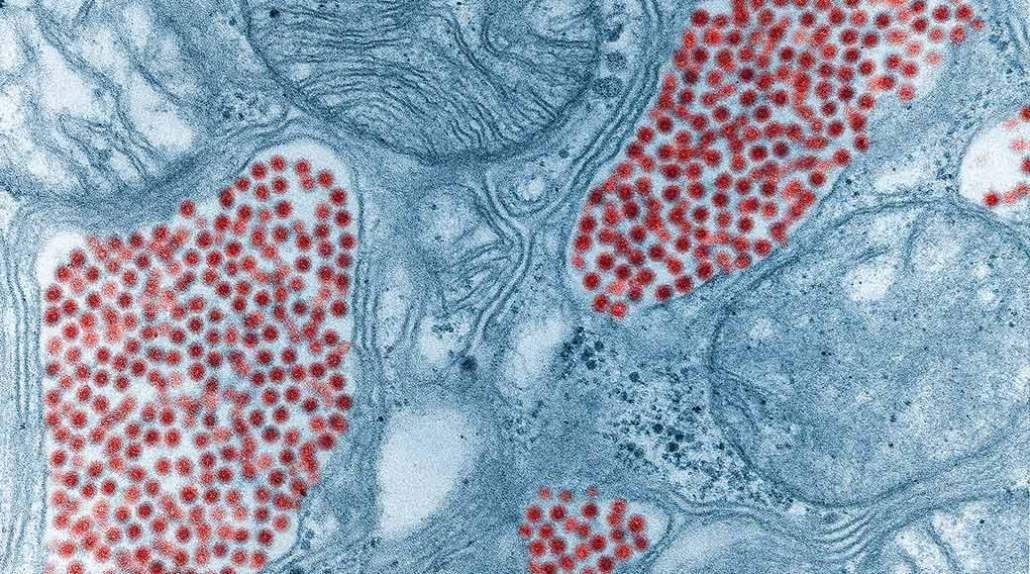
Mosquitoes can spread the virus that causes eastern equine encephalitis. This microscope image shows a mosquito’s salivary glands infected with the EEE virus (red).
Fred Murphy, Sylvia Whitfield/CDC
The worst outbreak of eastern equine encephalitis since U.S. health officials began monitoring the mosquito-borne disease 15 years ago is prompting aerial bug spraying and dire warnings to avoid the biting insects well into fall. As of October 1, 31 cases — including nine deaths — have been reported by the U.S. Centers for Disease Control and Prevention.
Known as EEE or Triple-E for short, the incurable brain infection is still relatively rare — there have been only 103 reported infections in the United States in the past decade. Only five percent of people bitten by an infected mosquito will develop the disease. But about a third of EEE patients die, and many who survive experience permanent neurological problems.
Science News spoke with several researchers about how the virus spreads, and possible factors that might be contributing to the recent surge in cases.
“We don’t know some of the basic details about these [mosquito-transmitted] diseases, unfortunately,” says pathobiologist Stephen Higgs, director of the Biosecurity Research Institute at Kansas State University in Manhattan. “The ideal is to anticipate outbreaks, which is very, very difficult. But we need to be prepared for an outbreak when it comes.”
How does the virus spread?
The virus that causes eastern equine encephalitis is initially carried by Culiseta melanura mosquitoes, which feed on blood from birds (SN: 4/9/19) and rarely bite humans. However, other mosquito species, including Aedes mosquitoes, can pick the virus up from infected birds and then spread the virus to humans and other mammals, including horses — which is how EEE originally got its name.
When an infected mosquito bites a person, the insect spits a solution of substances that help prevent blood from clotting, making it easier to suck blood. “That’s why you might have that little red bump — because it’s spitting into you,” Higgs says. “If there are viruses in those salivary glands as it’s spitting, it will also spit virus into you.”
Lion’s share
About 30 percent of the 103 eastern equine encephalitis cases recorded in the last decade have occurred in 2019. On average, there are about seven human cases of EEE in the United States each year.
Confirmed cases of eastern equine encephalitis, 2009–2019*
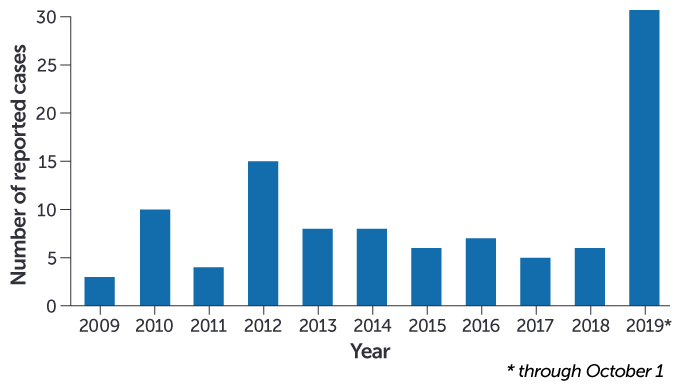
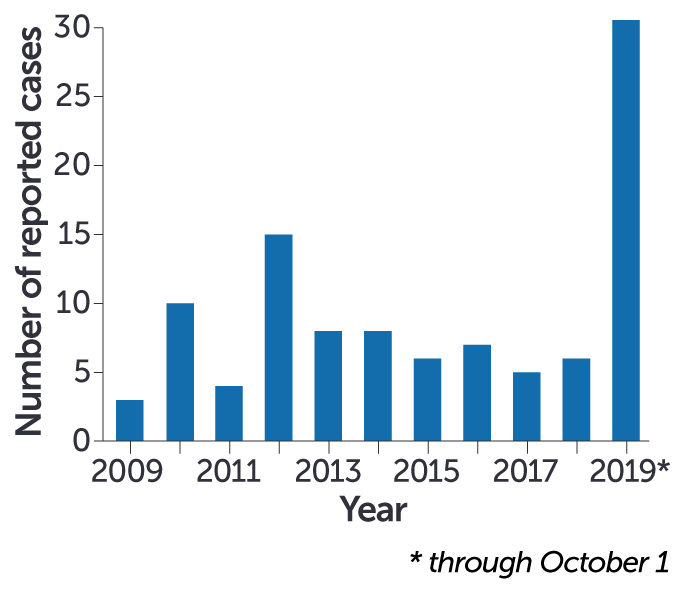
What are the symptoms?
Infected patients may first experience a fever, headache, chills or muscle and bone pain. If the virus moves to the central nervous system, it can cause encephalitis, or swelling of the brain. With no cure for EEE, doctors can only treat the symptoms and help to boost a patient’s immune response to the infection.
Where are people getting infected?
The northeastern United States has been most affected by the disease, along with states along U.S. Gulf Coast and in the Great Lakes region. These states tend to have humid forests and swampy areas where mosquitoes like to breed.
Of the 31 cases confirmed as of October 1, 12 have been in Massachusetts, nine in Michigan, three in New Jersey, three in Rhode Island, two in Connecticut, one in North Carolina and one in Tennessee, according to CDC spokeswoman Maggie Silver. At least nine people have died, according to the CDC’s Oct. 1 tally.
“We’ve got cases in states which have really not typically had human cases,” including Tennessee, Higgs says. And Connecticut, with two new cases, had only seen one other case, in 2013. Virus also has been detected in 2019 in mosquitoes in several states — including Maine, New York and Louisiana — that have not had human cases this year.
On the map
The eastern equine encephalitis virus has infected humans in 22 U.S. states, mostly around the Gulf Coast, in the Great Lakes region and along the Atlantic coast. In 2019, Tennessee became the 22nd state to record a case.
U.S. states with confirmed eastern equine encephalitis cases, 2009–2019*
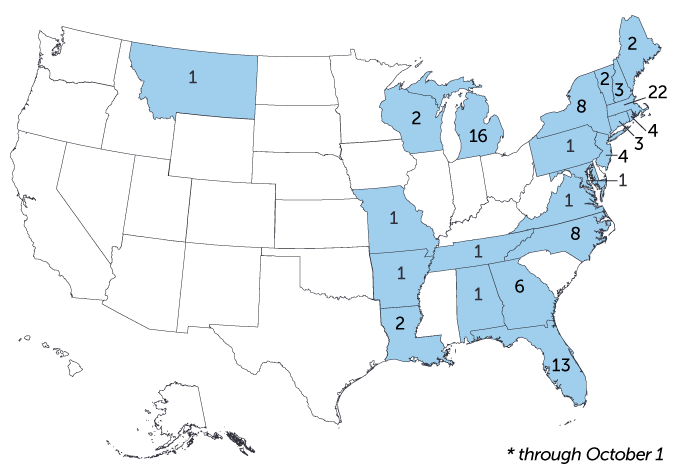
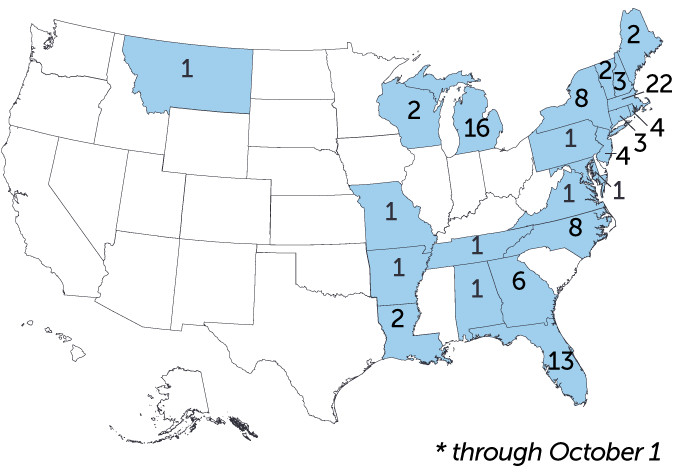
What’s causing this spike in EEE cases?
Researchers aren’t sure, but suggest a combination of factors could be to blame. Also unclear is whether the current disease surge is an anomaly, or if the country might see higher numbers of cases in future years as well.
“With any mosquito-borne disease, it’s cyclical,” says Silver. The number of cases rises in summer, when mosquito populations swell, and declines as temperatures drop and frost kills off the adult insects.
Conditions that encourage mosquitoes to proliferate can increase the disease risk, such as warmer temperatures (SN: 3/13/12). “One of the reasons we’re seeing outbreak cycles more frequently is probably related to the fact that the mosquito breeding season is longer now,” says Catherine Brown, state epidemiologist with the Massachusetts Department of Public Health in Boston. That’s cause for concern, given that climate change is pushing average temperatures up across the globe (SN: 7/1/19).
Rainfall can also have an effect. Because mosquitoes lay their eggs in standing water, small pockets of undisturbed water are crucial for breeding. And lots of rain means more such breeding grounds, which could “set up the stage for us to have very large mosquito populations,” Brown says.
What can people do to protect themselves?
The best way to prevent a Triple-E infection is to avoid being bitten by a mosquito in the first place. The CDC recommends using insect repellents, wearing long sleeves and pants and keeping doors and windows closed. People also can make sure there is no standing water around their homes, and avoid other breeding areas such as swamps at dawn and dusk, when mosquitoes are most active.
Some counties in affected states including Massachusetts have begun spraying against mosquitoes. “Aerial spraying is a way to cover large geographic areas in a relatively efficient way,” Brown says. But it can’t eliminate the EEE infection risk or get rid of all mosquitoes. “It’s not a magic bullet.”







